In recent years, the horse show industry has been witness to a growing trend. Long, flowing manes have become a common sight, and not just in the western pleasure and ranch riding arenas. Events as traditional as showmanship and equitation have experienced an increasing number of horses showing with long manes.
For years, the industry standard, particularly in all-around competition, was the traditional (short) banded mane in western events and a braided mane in hunter events. A few elder statesmen such as Zippos LTD and Harley D Zip made the roached mane acceptable.
So, GoHorseShow wants to know, what’s at the root of this latest long locks look?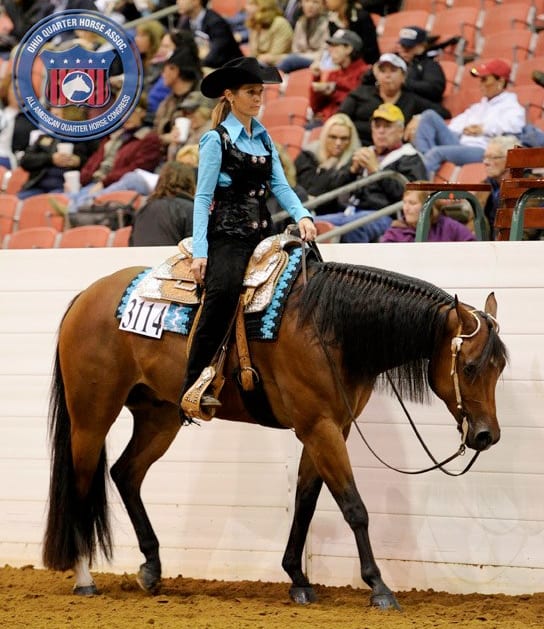
Grow Baby Grow
Candy Parrish (pictured right) owns and operates Parrish Quarter Horses with her husband Bret and son Cody in Pavo, Georgia. The family specializes in training western pleasure horses. According to Parrish, “We are seeing more long manes in the show pen these days. To me, it’s kind of a western style, and on the right horse it really looks good.”
All-around trainer and judge Gretchen Mathes (pictured left) of Powder Brook Farm in Harwinton, Connecticut believes that many exhibitors are moving toward long manes as a way to stand out from the competition. She says, “A long mane is  definitely a different look than a traditional banded mane. There’s no doubt that a well presented long mane sets you apart from the competition.”
definitely a different look than a traditional banded mane. There’s no doubt that a well presented long mane sets you apart from the competition.”
Tara (Lombardo) Landon has noticed more long manes in her work as a professional braider and bander on the show circuit. She says, “My take is that the popularity of the ranch riding has a lot to do with it. Horses are coming out of the pasture as two-year-olds with a long mane that’s pretty and the owner is doing the all-around and ranch riding. So, in that case, it’s just easier.”
The Awkward, In-Between Stage
 Timing is everything. At least when deciding to let your horse’s mane grow. In their business of training futurity horses, Parrish says that they prefer to allow their young horses’ manes to remain long. “We like manes that have never been cut or pulled to a short length. In my opinion, if you try to grow them out, they really never look natural and it takes a long, long time to get length.”
Timing is everything. At least when deciding to let your horse’s mane grow. In their business of training futurity horses, Parrish says that they prefer to allow their young horses’ manes to remain long. “We like manes that have never been cut or pulled to a short length. In my opinion, if you try to grow them out, they really never look natural and it takes a long, long time to get length.”
But for many exhibitors, starting with a virgin mane just isn’t an option. That’s where the timing comes in. “The growing process can be a little long, so try to choose the timing of when you start in terms of your show season. A good plan for most people is to start over the winter,” says Landon.
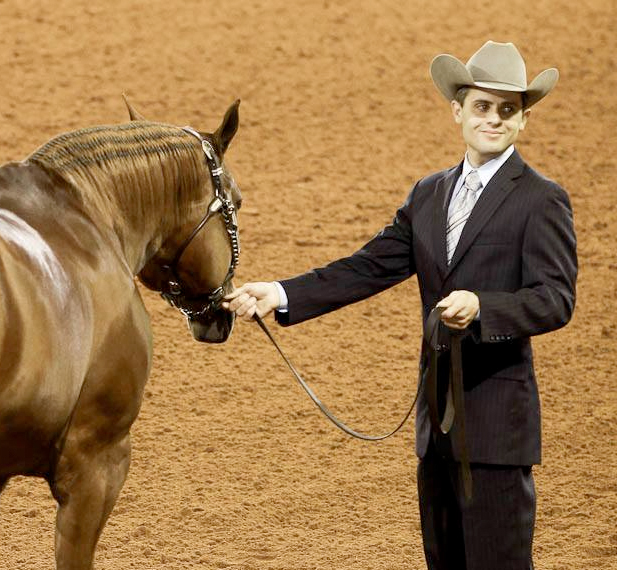 Mathes remembers when her amateur all-around client, Daniel Carlson (pictured left), decided to grow the mane out for his mare, Are You Charlie. He planned ahead and began at the end of the season. “Dan came to us in the spring and said, “I grew her mane all winter and I really want to try it long. She’s a very attractive mare, so we decided to give it a shot.”
Mathes remembers when her amateur all-around client, Daniel Carlson (pictured left), decided to grow the mane out for his mare, Are You Charlie. He planned ahead and began at the end of the season. “Dan came to us in the spring and said, “I grew her mane all winter and I really want to try it long. She’s a very attractive mare, so we decided to give it a shot.”
In other cases, Mathes says that a long mane can be used to enhance a horse’s looks. “We had one horse without a particularly pretty neck, and we used it to cover his neck. We also had one that was a little plainer. The long mane dressed him up and set him apart. The unifying factor was that each horse had hair quality that was well-suited to going long.”
Choosing a Competition Coif
 When it comes to show-ring presentation, opinions vary on the best method. Like many show trends, the reigning theory is that as long as the look is neat, clean, and polished the particulars depend on personal preference.
When it comes to show-ring presentation, opinions vary on the best method. Like many show trends, the reigning theory is that as long as the look is neat, clean, and polished the particulars depend on personal preference.
In the western pleasure pen, Parrish says it’s essential to maintain top line integrity. “We like to band our long-maned horses for the show pen. This keeps the mane laying flat and is not distracting to the top line of your horse while showing. Personally, we like two rows of bands on long manes.”
“For me, it depends on the event,” says Landon. “Some people choose to leave a long mane out for weekend shows. It can be acceptable so long as the hair’s not blowing around. But a messy, blowing mane is offensive.”
 In terms of particular styles, a lot depends on the mane’s thickness and texture. “Depending on the horse, I typically do anything from tiered bands to partial braids.” She adds, “In the performance halter, one row of bands is all you need. From there, depending on the kind of mane, the thickness, and how it lays and flows, I might do two or three rows of bands with different patterns—those tend to be my go-to styles for pleasure and trail. If you’re showing in conservative classes, like horsemanship and showmanship, the mane must be clean, crisp, and sleek. For those classes, I don’t like the elaborate designs.”
In terms of particular styles, a lot depends on the mane’s thickness and texture. “Depending on the horse, I typically do anything from tiered bands to partial braids.” She adds, “In the performance halter, one row of bands is all you need. From there, depending on the kind of mane, the thickness, and how it lays and flows, I might do two or three rows of bands with different patterns—those tend to be my go-to styles for pleasure and trail. If you’re showing in conservative classes, like horsemanship and showmanship, the mane must be clean, crisp, and sleek. For those classes, I don’t like the elaborate designs.”
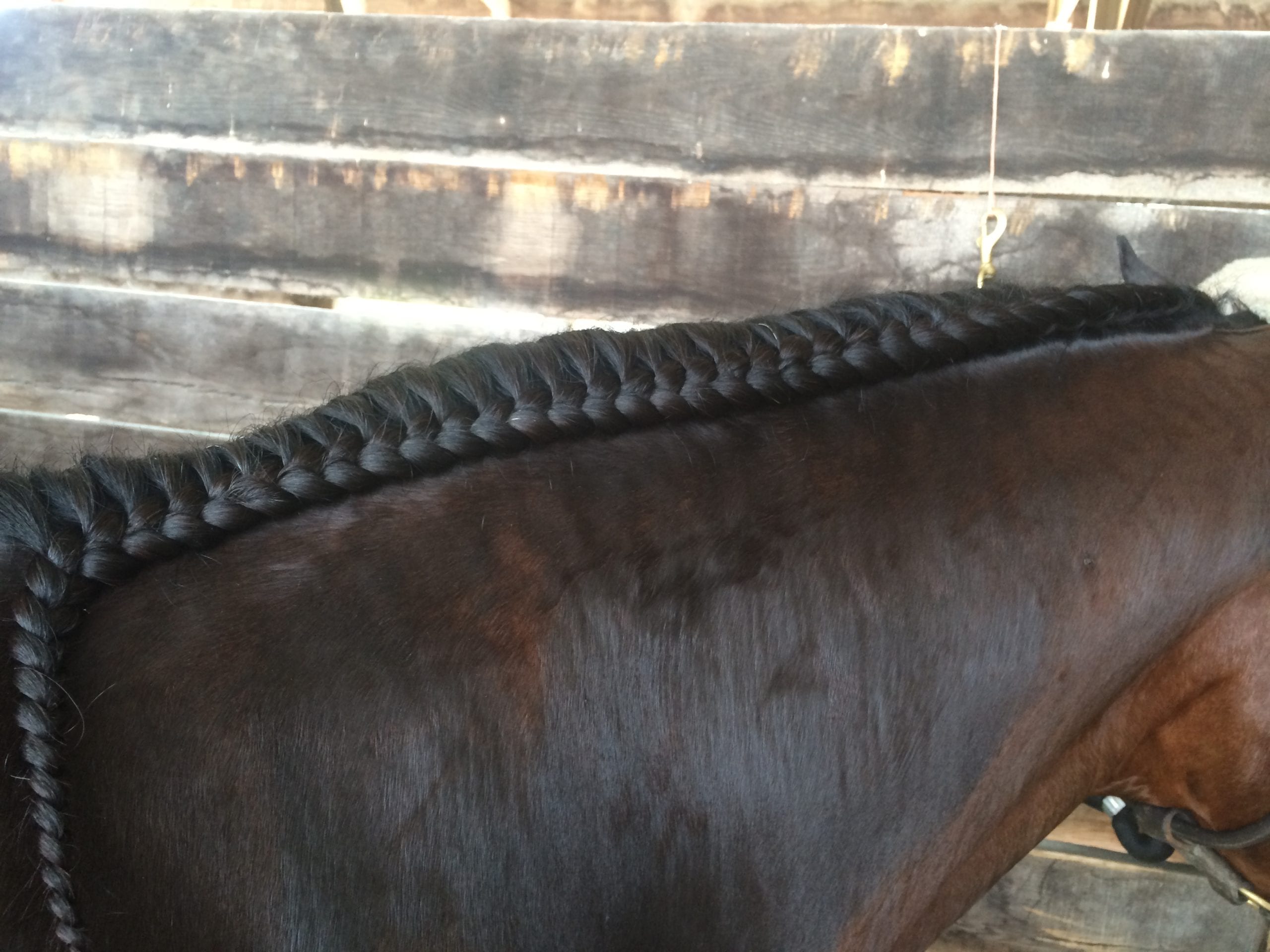 Finally, Landon says, “If you have a long mane and are doing equitation or hunt seat events, you definitely need to do a running braid. You absolutely do not want to have a flowing mane in English events.”
Finally, Landon says, “If you have a long mane and are doing equitation or hunt seat events, you definitely need to do a running braid. You absolutely do not want to have a flowing mane in English events.”
Mathes agrees, saying, “I like the long manes for western-based, all-around horses, but I don’t care for a long mane on an equitation horse — that’s just my preference.”
Mathes urges competitors to be ready to spend extra time and money if they’re planning to show with a long mane. “The first priority is that the mane is neat, clean, and still. When it’s presented that way, I think it’s beautiful. With, Are Your Charlie, it gives her that finishing touch.”
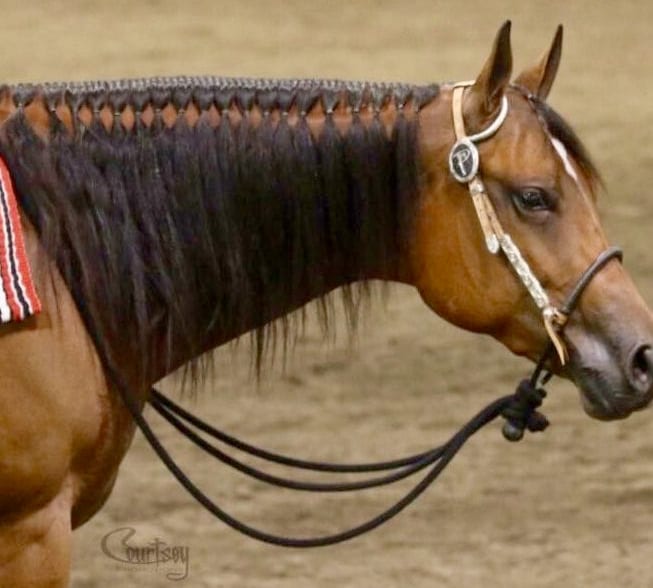 She adds, “But prepare to pay a little more when you get your horse banded. Really, the person is doing two and a half band jobs; plus, it takes longer to pull those lengths of long hair through neatly and without breakage.”
She adds, “But prepare to pay a little more when you get your horse banded. Really, the person is doing two and a half band jobs; plus, it takes longer to pull those lengths of long hair through neatly and without breakage.”
When it comes to what the judges want, Mathes offers this advice. “I don’t think judges have a strong preference either way. They just don’t have time for that. If it’s a disaster they’re going to see it. But if its neat, clean, and contained it will just be impressive.”
Long Hair Don’t Care
 While #longhairdontcare may be a popular Instagram tag for long-maned ladies, the equine hair pros warn that if you choose to let your horse’s mane grow, a great deal of care is required. “Long manes do require more upkeep,” says Parrish. “We try to keep long manes as clean as possible to avoid tangles and breakage. Sometimes we keep them in long braids to help keep them neat.”
While #longhairdontcare may be a popular Instagram tag for long-maned ladies, the equine hair pros warn that if you choose to let your horse’s mane grow, a great deal of care is required. “Long manes do require more upkeep,” says Parrish. “We try to keep long manes as clean as possible to avoid tangles and breakage. Sometimes we keep them in long braids to help keep them neat.”
Mathes agrees that maintaining a long mane takes considerably more time and effort. “It’s a lot of work. We focus on keeping the mane clean. After it’s washed I always use a leave-in conditioner. When I band, I do them wet after applying the leave-in. Throughout the show, we hood them like a normal horse, then we wash the mane again when the bands come out.”
At home, Mathes says their approach to mane care is very hands-off. “We leave them down and don’t touch them. Sometimes we do a braid around the wither to keep them out of the way when riding, but that’s it.”
For horses that show frequently, breakage can become an issue, says Landon. According to her, taking extra time and attention when removing bands is important. “Bands break hair off, especially if the hair is naturally dry and brittle. Never pull bands out of a long mane, instead use a seam ripper to cut them out.”
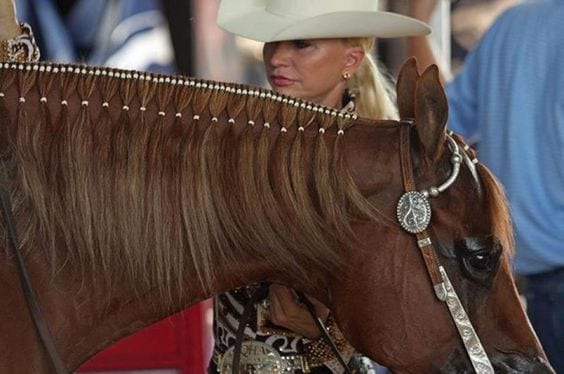 (Pictured left, Multiple AQHA World and Congress Champion Ona Good Impulse who is famous for her long mane.)
(Pictured left, Multiple AQHA World and Congress Champion Ona Good Impulse who is famous for her long mane.)
Parting Words
Parrish echoes the thoughts of both Mathes and Landon with this advice to those considering a long mane.
“If your horse has a thick and full long mane, then they really can be beautiful in the show pen. But honestly, not many horses are a good fit for long manes. A naturally thick and naturally long mane is a must. Just remember, a horse with a short, neat mane is better than a horse that doesn’t grow a good long mane.”
Landon adds, “I think it’s always worth a try. If you get halfway and see it’s not the right texture or won’t lay over, you can always cut it off.”
So, if you’re feeling the urge to try something new and think your horse has the locks to pull off a new look, stock up on bands and conditioner and let it grow!
Photos @ Mallory Beinborn/Impulse Photography, Tara Landon, KC Montgomery, Courtsey Promotions, Jeff Kirkbride, The American Quarter Horse Journal, Gretchen Mathes








